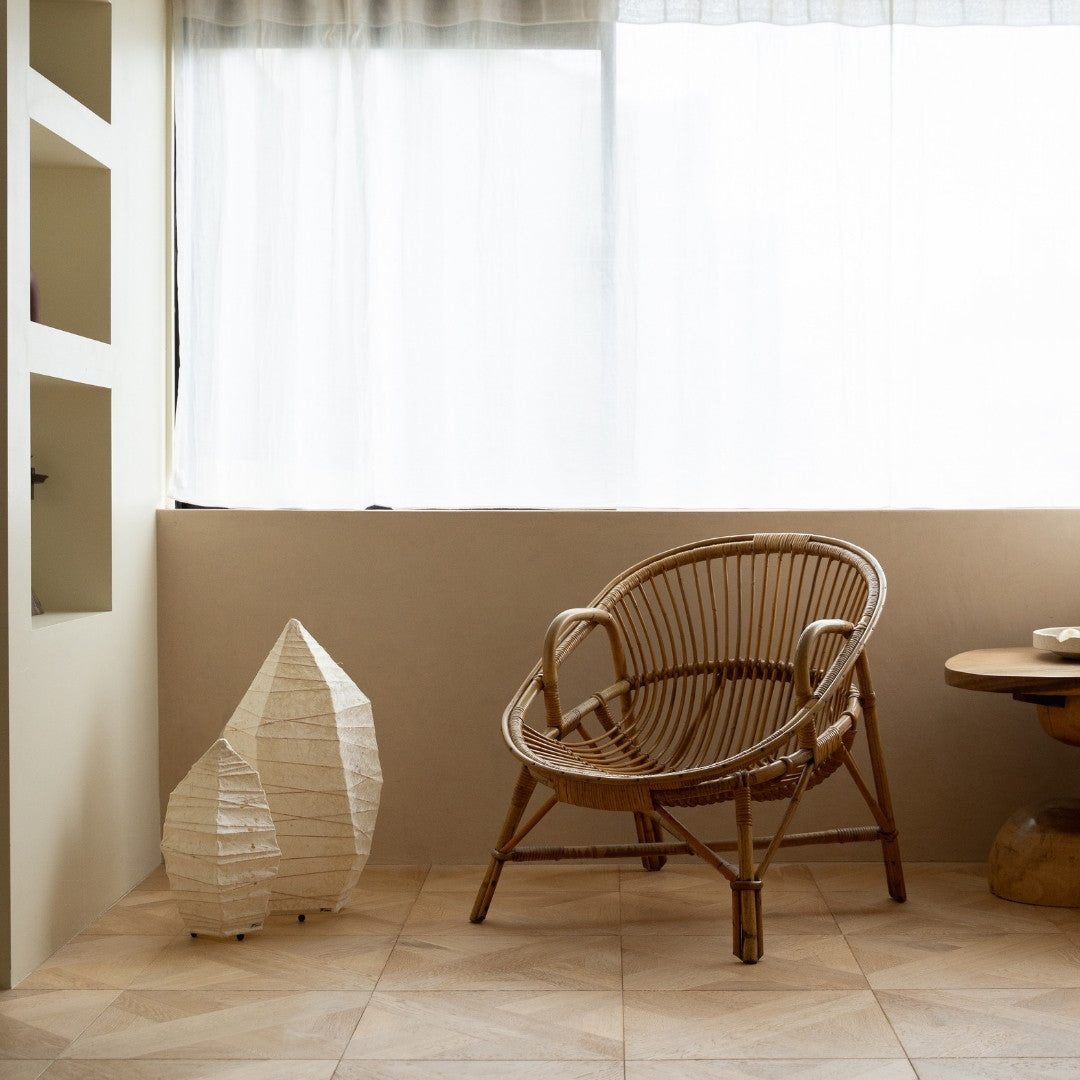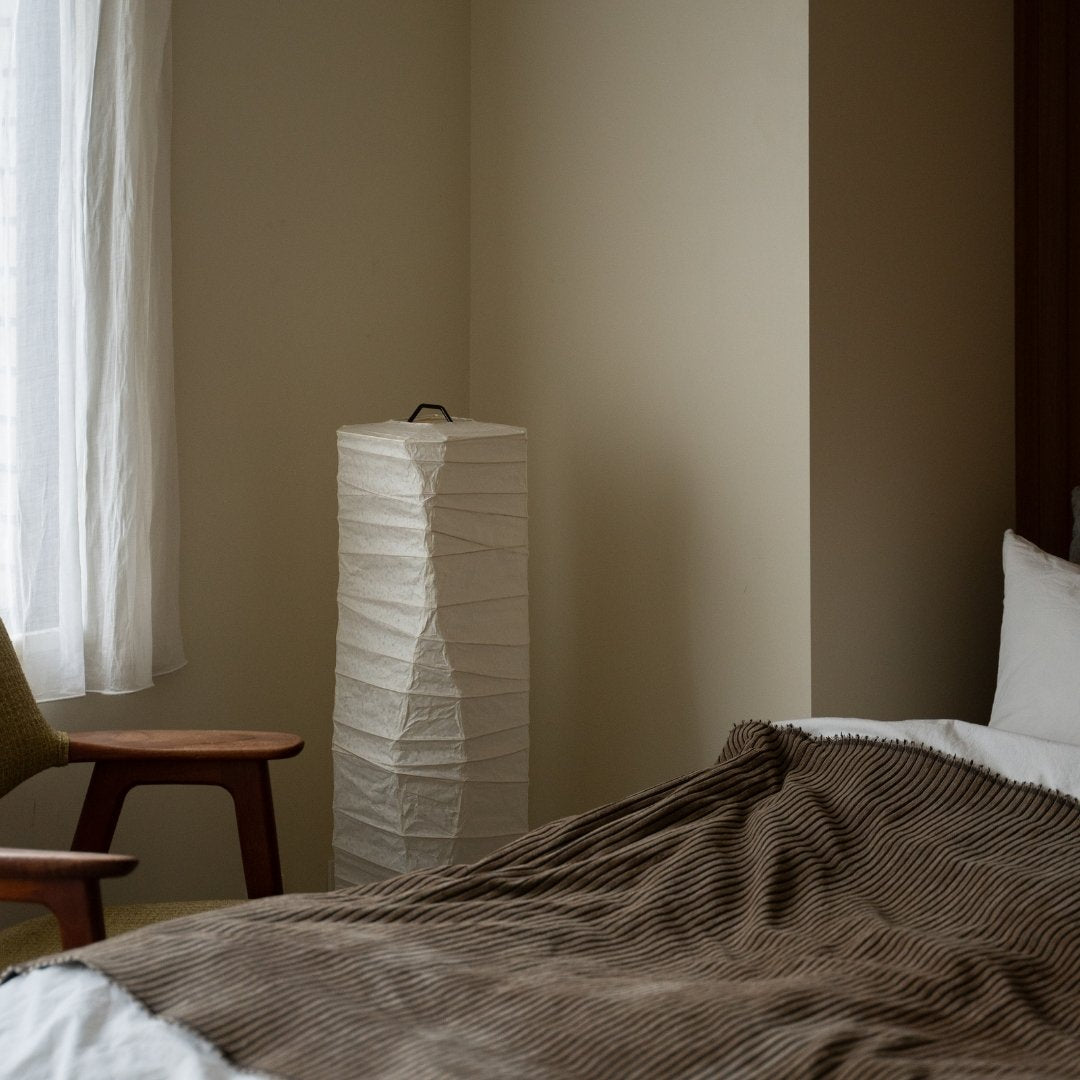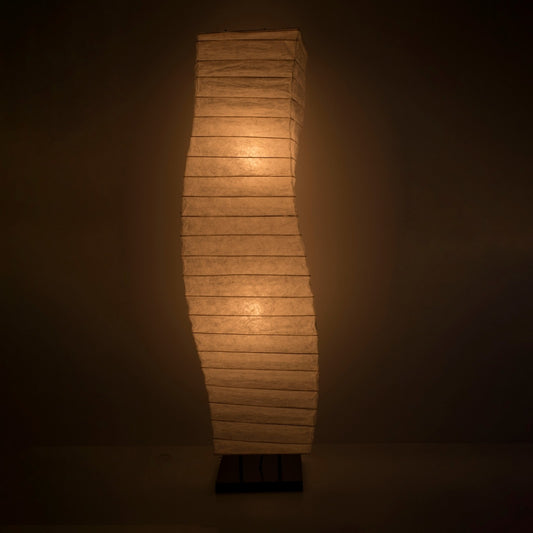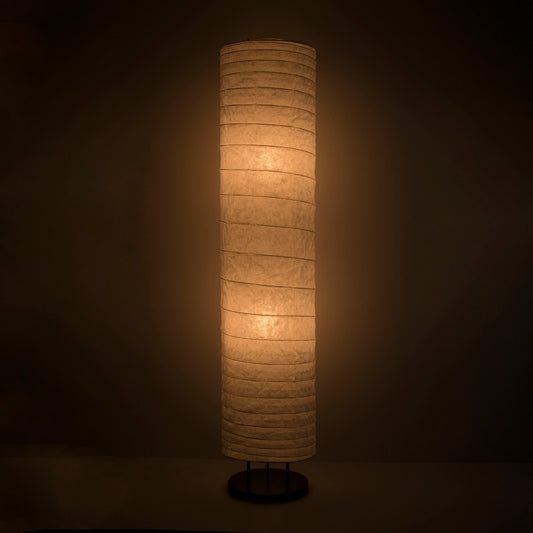
Japandi Style Living Room: Create Serene & Minimal Interiors
Share
As urban landscapes expand and digital noise permeates our daily lives, the need for spaces that offer solace, cultivate mindfulness, and foster a deeper connection with nature is growing. This universal desire for calm and comfort has given rise to Japandi style, a captivating design aesthetic. It is a harmonious fusion of two distinct yet deeply complementary philosophies: Japan's "Wabi-Sabi" – a profound appreciation for the beauty of imperfection and impermanence – and Scandinavia's beloved "Hygge" – an embrace of comfort, coziness, and well-being. Japandi offers a unique solution to the modern dilemma of finding serenity amidst chaos.
This article will extensively explore the origins of Japandi style, its core principles, and its profound impact on contemporary living. While Japandi aesthetics can be applied throughout the home, we will focus particularly on the living room, traditionally the heart of the home. It is in the living room, the central gathering place, where Japandi's signature blend of serene beauty, warm comfort, and emphasis on intentional living can be most powerfully expressed and experienced. We will delve into the specific elements that define a Japandi living room, offer practical tips for transforming your own space, and reveal how to truly enjoy the profound calm and clarity this exquisite design philosophy brings.
Table of contents
What is Japandi Style?
Japandi style represents a design ethos born from the confluence of two rich cultural traditions. At its core lie shared values of minimalism, a deep reverence for nature, and the pursuit of simplicity in living. These principles are not merely decorative choices in interior design; they are deeply rooted in the values and philosophies of both Japanese and Scandinavian cultures, whose sophisticated interplay forms the very foundation of Japandi design.
From the Japanese perspective, "Wabi-Sabi" signifies the beauty found in imperfection, the transience of things, and the way natural materials age and patina, acquiring character and new beauty through time rather than deteriorating. It is an aesthetic that values authenticity over perfect symmetry, the well-worn over the brand new, and the subtle stories embedded in natural textures. Meanwhile, Scandinavian "Hygge" emphasizes creating an atmosphere of warmth, coziness, and contentment. It's about savoring life's simple pleasures, fostering intimacy, and cultivating well-being through comfortable surroundings and intentional moments.
When these two philosophies intertwine, Japandi emerges as a powerful aesthetic that declutters not just the physical space of a home but also the mind, bringing serenity and harmony to everyday life. The combination of functionality and comfort, coupled with an embrace of nature's beauty within living spaces, has earned Japandi design widespread popularity globally. It is a design that speaks to a universal human need: a comforting refuge from the complexities of modern life.
Core Elements of a Japandi Living Room
The living room, as the social heart of the home and a sanctuary for relaxation, provides an ideal canvas for Japandi aesthetics. Here, the core principles of simplicity, natural beauty, and functional harmony converge to create an environment that is both deeply inviting and restorative. Let's delve deeper into the characteristics that shape a Japandi living room.
- Dominance of Natural Materials:
In a Japandi living room, furniture and decor made from natural materials are not mere accents; they are essential to achieving the sense of calm and comfort that are core tenets of the style. Wood is arguably the most prominent material, appearing in various forms such as solid wood sofa frames, minimalist coffee tables, and elegant wall slats, bringing a warm ambiance to the space. Wood choices often lean towards light tones like maple or darker, richer hues like walnut, creating subtle contrasts. Beyond wood, linen is widely used for soft furnishings like curtains, cushions, and throws, offering breathable, textured softness. Bamboo and washi paper frequently feature in elements like lampshades, providing delicate translucency and organic patterns. Stone, in the form of vases or decorative bowls, adds a grounding presence of natural elements. The thoughtful balance and interplay of these diverse textures create a peaceful, calming space that feels intimately connected to nature.
Harmonious Neutral Color Palette:
The color scheme is another hallmark of a Japandi living room, carefully curated to foster a sense of calm and contribute to mental relaxation. Neutral tones such as soft whites, creamy beiges, and various shades of gray form the foundation, creating a clean and open backdrop. These base colors are subtly enhanced by earthy accents like muted sage green, warm terracotta, soft dusty rose, or even deep, calming blues. This palette harmonizes seamlessly with natural materials, reducing visual noise and supporting a space that encourages mindfulness and tranquility. The absence of jarring, bright colors allows the eye to rest and the mind to find peace, creating a tranquil and clear environment.Intentional Minimalist Design:
The minimalist approach in a Japandi living room is not a lack of design but the result of highly deliberate choices. Furniture and decor are pared down to the essentials, with a strong emphasis on clean lines, understated forms, and an intentional appreciation for negative space. Clutter is rigorously avoided as it detracts from the sense of calm and clarity. This is achieved through thoughtful design elements like built-in storage solutions and multifunctional furniture. For instance, a coffee table might incorporate subtle storage, or a sleek console table might integrate hidden drawers. This streamlined design offers both aesthetic purity and emotional clarity, key ingredients in a comfortable and practical Japandi interior. The goal is to create an environment where everything has its place and purpose, contributing to an overall sense of order and serenity.Emphasis on Uncompromising Functionality:
The design of a Japandi living room is a testament to the harmonious fusion of beauty and functionality. Every piece of furniture and decor is chosen not only for its aesthetic appeal but also for its practical utility. Multi-purpose furniture and cleverly integrated hidden storage are key to maintaining an open, spacious, and clutter-free environment. The placement and height of furniture are meticulously planned to suit natural movement and sightlines, ensuring seamless flow and making even a small Japandi living room feel spacious and unconfined. For example, low-slung furniture enhances the sense of openness by drawing the eye further. This design philosophy significantly improves not just the look of the space but also its efficiency and ease of use in daily life, making the living room a truly comfortable and practical sanctuary.- Artful Use of Natural Light and Thoughtful Illumination:
In a Japandi living room, the strategic use of natural light and the carefully considered placement of artificial lighting are paramount. Large windows, often dressed with sheer linen curtains, allow soft, diffused daylight to generously fill the space during the day. This creates an open, bright, and uplifting atmosphere. At night, indirect lighting takes center stage. Washi paper floor lamps or table lamps, which diffuse light evenly, along with warm-toned lighting, create layered ambient lighting, resulting in a soft, inviting, and relaxing space. Warm-toned lighting is preferred as its hue is more conducive to relaxation compared to daylight-toned lighting, enhancing the room's coziness. The interplay of light and shadow is meticulously planned, contributing significantly to the calm and inviting atmosphere that defines Japandi decor.
Tips for Transforming Your Space into Japandi style
The journey to transforming your living room into a Japandi sanctuary can be both exciting and rewarding. It involves a mindful approach, paying close attention to selection and placement, and prioritizing authenticity and the inherent qualities of materials.
- The Art of Decluttering and Simplifying:
The first and most crucial step in creating a Japandi living room is to simplify. Embrace the 'less is more' philosophy. Remove anything that doesn’t serve a clear purpose, spark joy, or contribute to the overall calm aesthetic. This creates a blank canvas, allowing selected Japandi elements to truly shine and emphasizing "negative space." Start with larger items, then move to smaller accessories. Consider incorporating smart storage solutions from the outset to keep clutter neatly tucked away.
Invest in Quality Natural Materials:
Prioritize furniture and decor crafted from high-quality natural materials. Opt for solid wood for key pieces like coffee tables, sideboards, and shelving units, either in light tones (maple, light oak) or richer, darker shades (walnut). Incorporate linen for upholstery, curtains, and throws, embracing its texture and natural drape. Consider bamboo for lighting or small accent pieces. When choosing materials, think about their tactile quality and how they will age gracefully, developing a beautiful patina and telling a story over time.Cultivate a Serene Neutral Color Palette:
Base your walls and larger surfaces on soft, calming neutrals. Think off-whites, creamy beiges, or muted grays. Add warmth and subtle interest through earthy accents – consider throws or cushions in sage green, terracotta, or dusty blue. Avoid stark contrasts or overly vibrant colors that can disrupt the peaceful ambiance. The goal is a cohesive, harmonious palette that promotes visual and mental relaxation.Embrace Low-Profile Furniture and Clean Lines:
Opt for furniture with clean lines and a low profile. Low-slung sofas, minimalist coffee tables, and sleek, horizontal shelving units contribute to a sense of spaciousness and an unobstructed view, making the room feel larger and more open. This also aligns with the Japanese tradition of being closer to the ground, fostering a grounded and calming feel. Look for pieces that are functional yet aesthetically pleasing, without excessive ornamentation.- Maximize Natural Light and Layer Artificial Lighting:
Keep windows unobstructed to allow as much natural light as possible to flood your living room. Opt for sheer linen or cotton curtains that gently diffuse light rather than blocking it out completely. Natural light not only brightens the space but also highlights the warmth and texture of natural materials. In addition to maximizing natural light, carefully select artificial lighting to create a warm and inviting atmosphere in the evenings. Prioritize indirect, warm-toned lighting. Washi lamps (Japanese Paper lamps), bamboo lamps, or kumiko lamps are ideal for casting a soft, diffused glow and creating layers of ambiance. Use floor lamps for general light and table lamps to illuminate smaller, focused areas, fostering a cozy and intimate atmosphere.
Enjoying Your Japandi Living Room
A Japandi living room is not just to be admired; it's designed to be lived in, experienced, and to foster a particular way of being—one that cultivates calm, contemplation, and authentic connection. It is a space where the pursuit of well-being is subtly woven into the very fabric of its design.
Cultivating a Sanctuary for Relaxation and Rejuvenation:
The most immediate and profound benefit of a Japandi living room is its ability to serve as a true sanctuary. Its serene atmosphere, lack of visual clutter, and the gentle presence of natural materials all combine to create an environment conducive to deep relaxation. Unwind here after a busy day, perhaps by reading a book, listening to quiet music, or simply observing the play of light and shadow. The minimalist design reduces sensory noise, allowing the mind to quiet down and find a state of peace.Practicing Mindfulness and Intentional Living:
The Japandi aesthetic, with its emphasis on thoughtful curation and appreciation for natural elements, inherently invites mindfulness. Take time to truly engage with your surroundings. Feel the smooth grain of a wooden table, observe the soft diffusion of light through a washi paper lamp, or appreciate the subtle imperfections in a handcrafted vase. By consciously interacting with your space, you cultivate a greater awareness of the present moment and a deeper connection to the objects around you, turning everyday experiences into meditative acts.Fostering Authentic Connection and Communication:
While Japandi values moments of solitude, its open layouts and comfortable, unpretentious atmosphere also make it an ideal space for fostering genuine connections with others. The arrangement of low-profile furniture naturally encourages closer interaction and conversation. The absence of distractions allows for more meaningful dialogue with family or cherished guests. The living room becomes a place where relationships are nurtured in a calm and inviting environment.Embracing Imperfection and the Passage of Time (Wabi-Sabi):
A key aspect of enjoying your Japandi living room is embracing the philosophy of "Wabi-Sabi." This means appreciating the beauty in imperfection, impermanence, and the natural cycle of growth and decay. Instead of striving for flawlessness, allow natural materials to age gracefully, developing their own unique patina, subtle wear, or slight imperfections that tell their story. A slight crack in a ceramic vase, the deepening tone of bamboo over time, or the gentle fading of linen fabric are not flaws but testaments to authenticity and character, adding depth and narrative to your space.
By consciously engaging with these aspects, your Japandi living room becomes more than just a beautifully designed space. It transforms into a living, breathing environment that actively nurtures your well-being, fosters inner peace, and enhances the quality of your daily life.
Japandi style into Your Home - A Journey to Harmonious Living
The Japandi living room, at its heart, is more than just a visual style; it represents a profound philosophy of living—one of serene, mindful comfort. The tactile nature of its materials and the gentle beauty of its quiet, intentional design come together to bring a perfect balance of relaxation and focused tranquility to daily life. This aesthetic champions sustainability, timelessness, and a deep respect for craftsmanship, encouraging a mindful approach to consumption and a lasting appreciation for the things we surround ourselves with.
At Millennium Gallery Japan, we curate an extensive selection of authentic Japanese home decor pieces that are perfectly suited for a Japandi style living room. Our collection ranges from exquisite handcrafted Japanese lamps that cast a warm, inviting glow, to elegant vases that celebrate the beauty of natural imperfection. We offer delicate incense to engage the olfactory senses, sophisticated tableware to elevate everyday rituals, and unique decorative objects to add quiet character to your space. Each item is meticulously crafted by skilled artisans, embodying centuries of tradition and a profound reverence for natural materials.
We encourage you to embark on an intentional and thoughtful journey to create a Japandi interior that truly reflects your values and lifestyle. Choose each piece with care, ensuring its unique story, material integrity, and inherent beauty resonate with you. This is not merely about decorating a room; it's about curating an environment that inspires tranquility, promotes well-being, and enhances the quiet richness of everyday life. Let Millennium Gallery Japan be your guide in discovering the perfect pieces to complete your Japandi living room with quiet elegance, profound authenticity, and enduring harmony.















